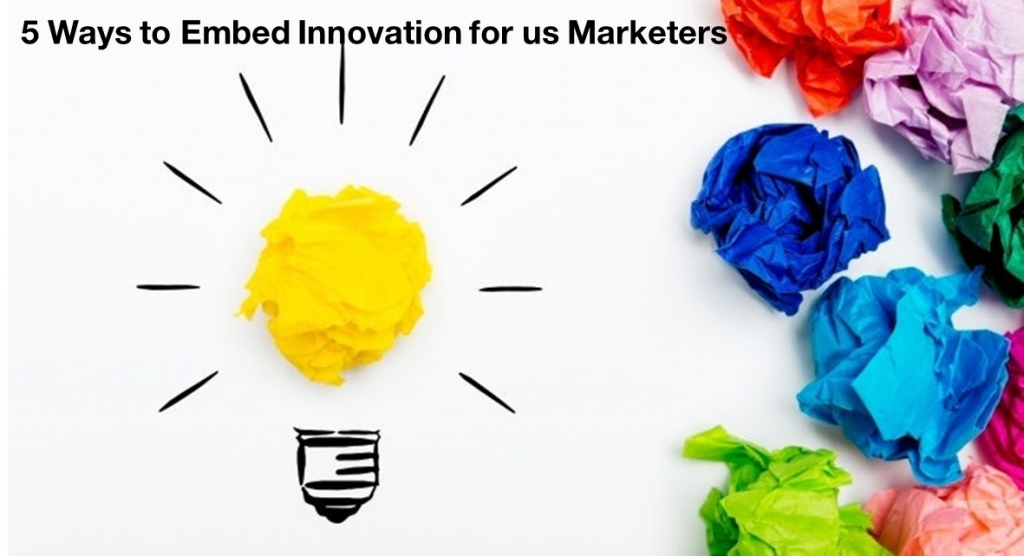We live in an age of technological acceleration and marketers are on the frontline. New ideas, new channels and disruptive technologies appear to be coming at us exponentially faster. The two most commonly cited responses to this rapid product and technological advancement (or indeed obsolescence) is to ‘disrupt yourself’ or to ‘innovate more’.
But what exactly is innovation? There is a plethora of opinions regarding innovation and why it is important. Innovation is about novelty and new ideas, about how we might create new products or services, business models or processes. The ability to develop new ideas and innovations is seen as a priority for many brands.
We all know we need to do it, but effectively and deliberately creating the new and the different has proven elusive. What most think of as ‘innovative’ or ‘disruptive’ focuses on keeping what we already know going and delivering incremental improvements. We turn out improved products and improve the methods to market them. Indeed, even those brands touted as ‘disruptive’ may not be so. Clayton Christensen, the Harvard professor who coined the term ‘disruptive innovation’ in ‘The Innovator’s Dilemma’ claims that Uber is not disruptive but innovative, while Netflix truly is disruptive.
The trouble with innovation
I believe that understanding innovation has to be a critical focus for every marketer who has a big future for their brand (and for their career) in mind. Managing and understanding innovation will increasingly become the challenge and test of a marketer’s competence.
Paradoxically, marketers are often viewed as the source of innovation, given that we are often closer to the customer. But then the trouble begins: few of us know how to effectively to ‘do’ innovation, often because systematic processes have traditionally been the realm of research and development. Or, it’s mixed up with being some kind of voodoo magic that only the chosen few have access to.
I think there are a number of reasons why innovation is problematic – and will continue to be so:
- Our fear of failure: If we fail, we won’t get the promotion, or we will invest too much of our time, or too much money. Or worst of the lot, we will be blamed for the failure of our new product.
- Our cognitive biases: These cause us to think in a local and linear fashion. But lots of technologies are growing at an exponential pace, so the future is much more unpredictable than we can imagine. Who could predict that easy online access to worldwide suppliers (e.g. through Alibaba) would mean that a small startup can compete with the biggest brands, or the collapsing cost of making craft beers and white spirits would mean you could take on Diageo?
- Our customers: We are told to be close to the customer, but in research people are not often the best judges of their own future tastes. Focusing on customer desires may not always be robust advice. Instead of trying to solve a problem or fill a gap in the marketplace, real disruptors such as Netflix are about creating new capabilities.
- Our view of innovation: Our paradigm of innovation is dominated by the notion of the sole inventive genius who creates something out of nothing. Total nonsense. Turns out that James Watt did not really invent the steam engine, or Edison the lightbulb, or James Dyson the bagless vacuum cleaner. Steven Johnson, author of ‘Where Good Ideas Come From’ points out that the majority of breakthroughs, from the spinning jenny to the sequencing and mapping of DNA, emerge in collaborative environments.
How to embed new methods
So, how do you innovate? Having worked on numerous innovation programmes, here are five strategies I recommend you adopt:
- Innovation as a business rather than as a function: Management guru Peter Drucker says that we must see innovation as a ‘business’, and to do this, it often has to be set up outside existing structures as an autonomous unit with the right environment, the right incentives and the right culture.
- Innovation as a mindset: The right way to address the problem is to create, build and maintain an innovation organisation; to know what innovation means and understand the dynamics. Thus, innovation becomes a culture based on attitudes, practices and mindsets – not a role that somebody has.
- Think ‘experimentation’ instead of ’success’: A strategy for innovation has to be based on a clear acceptance of the risk of failure. Expedia ran thousands of experiments per month in 2016 to test different features instead of the one per month that they were doing in 2011. They A/B test key features that are core to the business and choose the one that performs best. Some tests don’t work but they are informative and useful nonetheless.
- Think ‘collaboration’ internally and externally – not ‘lone ranger’: Few great products are developed by a single employee brainstorming in a cubicle. Great products are now about collaborative efforts internally and externally to bring a brilliant idea to market. As Johnson points out, the great innovation question is whether large organisations can better harness what he calls the ‘innovation turbine’ – all the people, startups and universities working on innovation – and tap into these flows to fundamentally alter the cultivation and promotion of good ideas.
- Use agile frameworks that work elsewhere: Innovation and experimentation are about methods and processes. I’ve been particularly inspired by the GV (formerly Google Ventures) ‘sprint’ methodology. This is a framework for teams of any size to solve and test problems in five days, ensuring the team is putting its time, talents and energies into rapid prototyping and focusing on customer acceptance as part of the process. It not only improves the selection mechanism, but also shortcuts the endless debate and approval mechanisms, compressing months into just a week. Sprints are perfect starting points when kicking off a new feature, product or business, or solving problems with an existing product.
Finally, I think the best innovation mindset for us marketers might be not to look at the big brands at all. They are usually (with some exceptions) slow-moving and tentative. Instead, we should be looking at the guys or gals running a company from their garage. They have nothing to lose. Maybe we should try to find them, emulate them, partner with them or even hire them.




